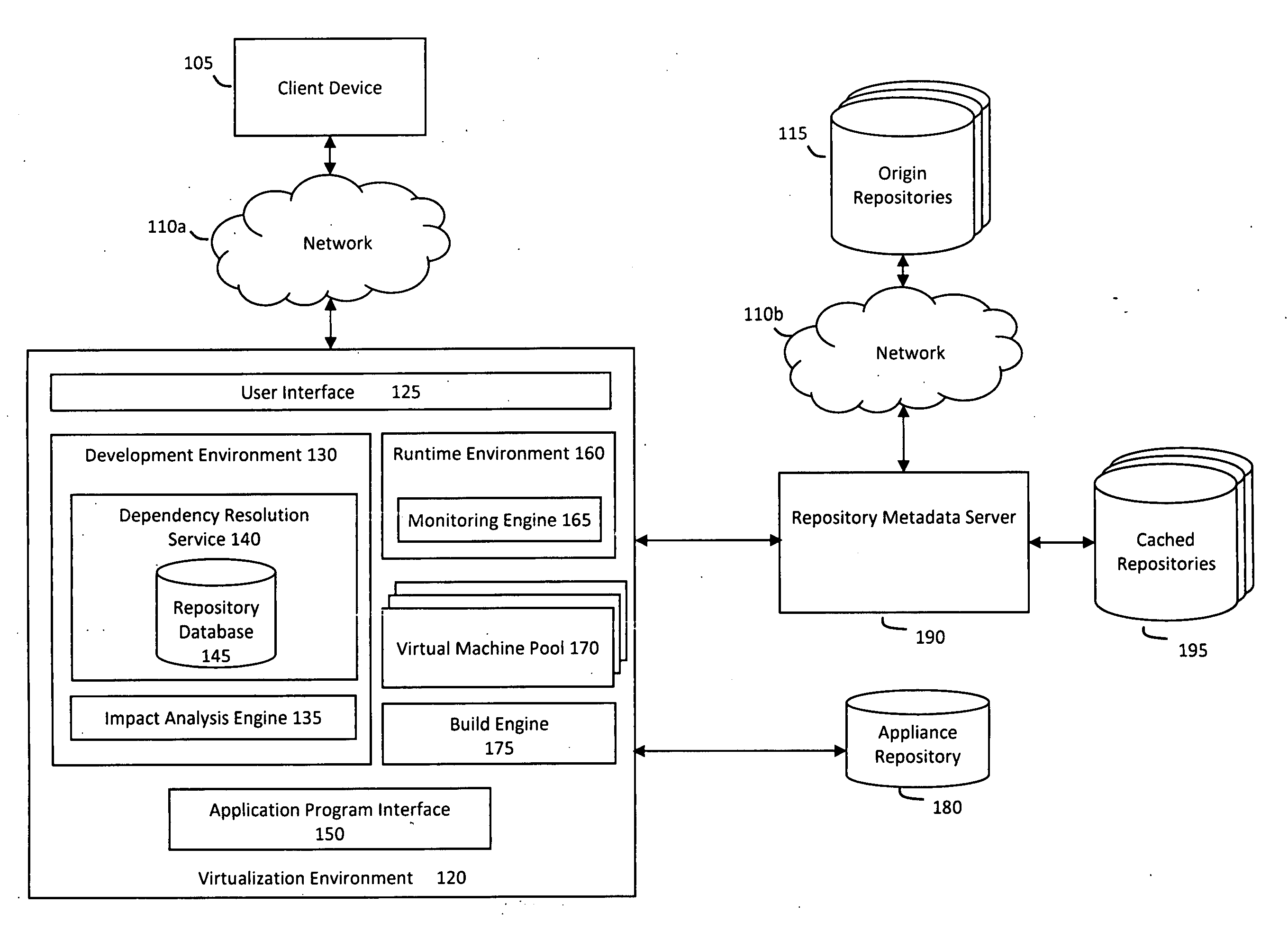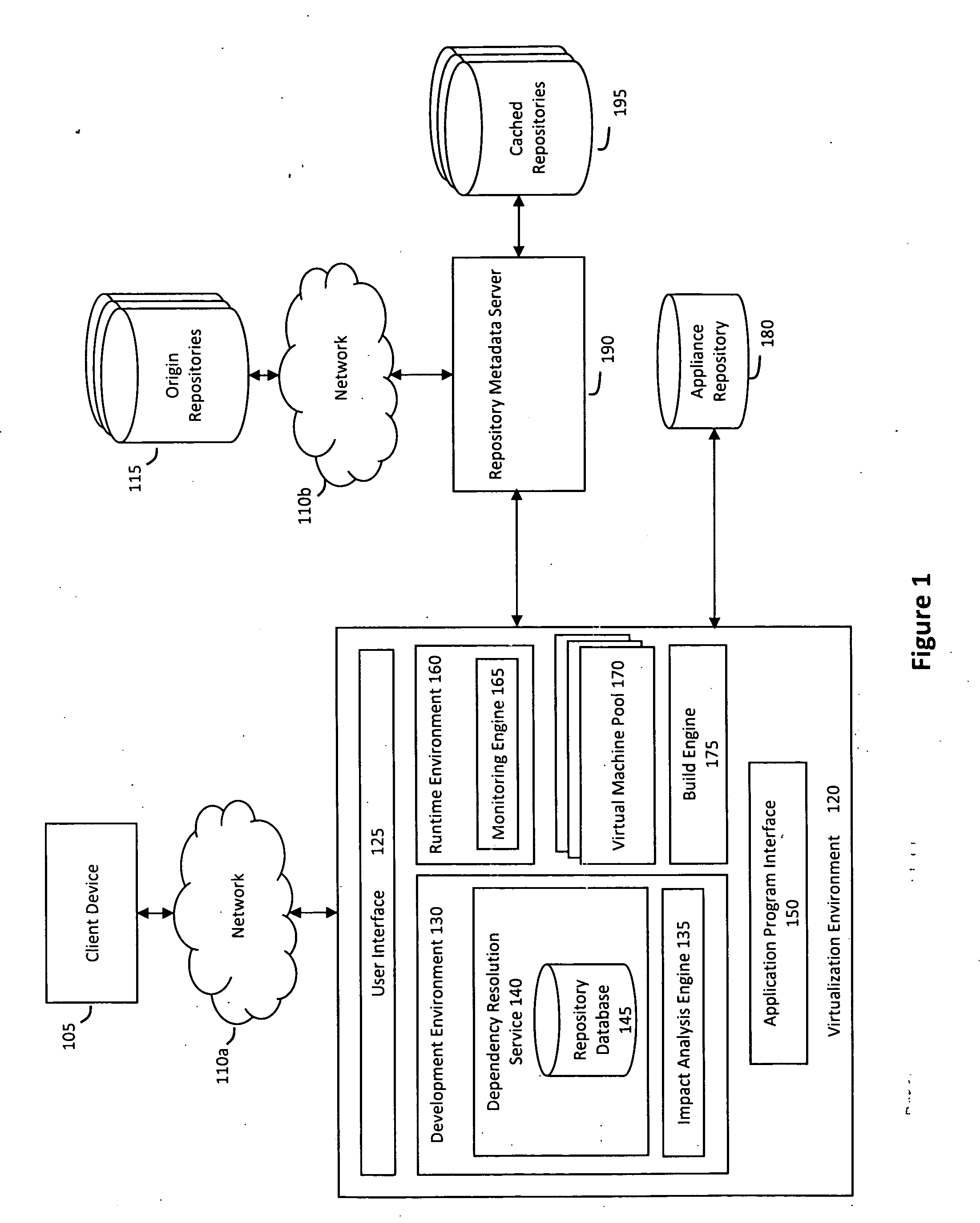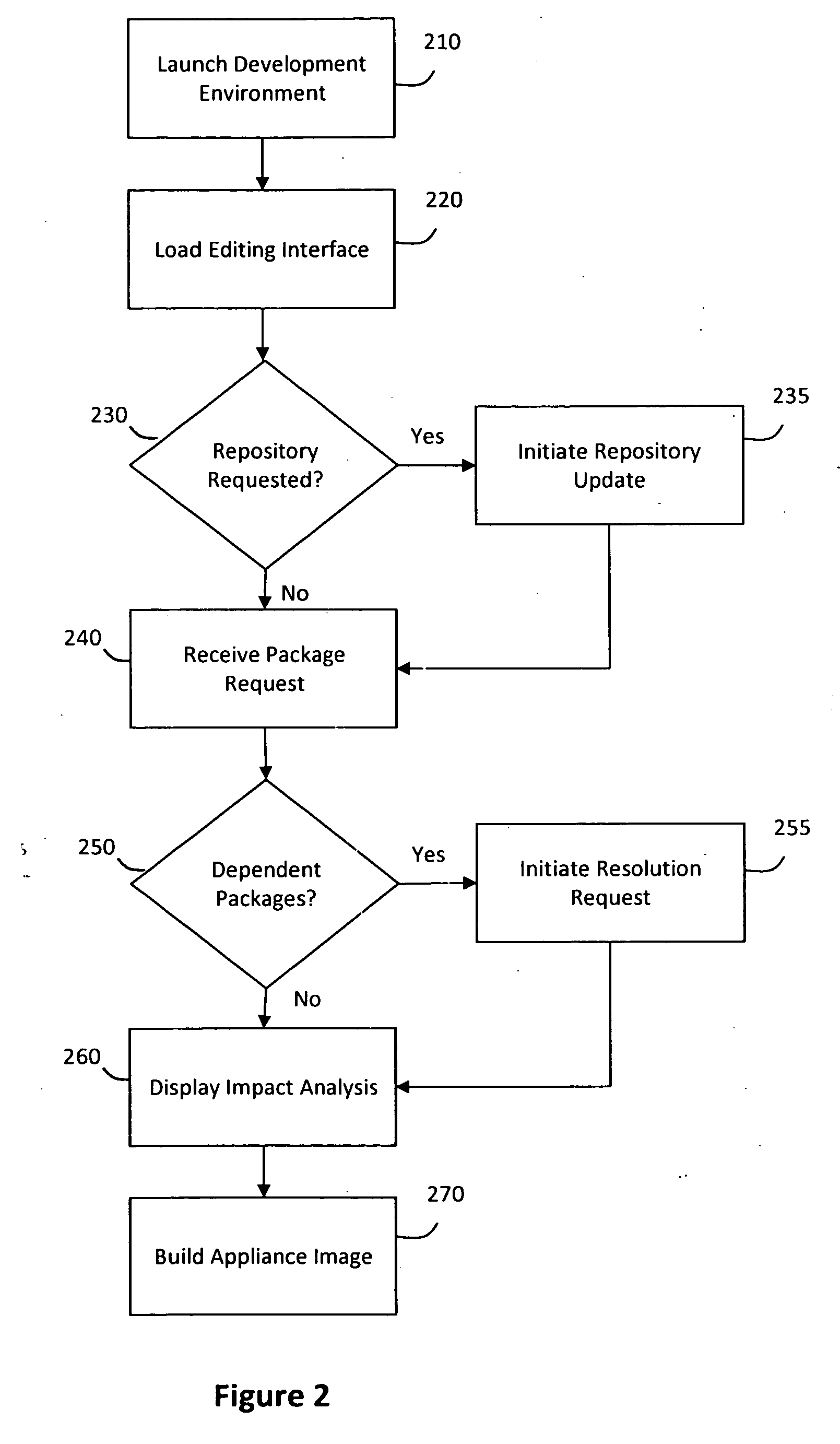[0006]According to one aspect of the invention, a
system and method for managing a virtual appliance lifecycle may address these and other drawbacks of existing systems. In particular, the systems and methods described herein may employ a hosted virtualization environment to provide a unified framework for developing, building, testing, deploying, and otherwise managing a virtual appliance lifecycle. As will be described in further detail below, integrating the functions of developing, building, testing, deploying, and otherwise managing the lifecycle of virtual appliances within the unified virtualization environment may provide various synergies. For example, the synergies provided through the integrated functions of the virtualization environment may include enabling users to follow a simple and repeatable process to build and configure a virtual appliance distribution, monitor upstream changes and modifications to virtual appliances in a collaborative and user-driven manner, and provide real-time analysis and feedback during various phases of the virtual appliance lifecycle.
[0009]According to one aspect of the invention, the virtualization environment may be associated with a repository
metadata server that caches information associated with various origin repositories (e.g., packages, patterns, or other software contained in the origin repositories,
metadata describing the origin repositories and the packages, patterns, or other software contained therein, etc.). As such, the editing interface may enable the user to interact with the repository
metadata server to add, remove, update, or otherwise query any suitable information cached from or otherwise associated with the origin repositories, and the user may further interact with the repository
metadata server to manage software for the virtual appliance (e.g., selecting packages, patterns, or other software to be included in and / or banned from the appliance). In addition, to assist the user in managing the software for the virtual appliance, the virtualization environment may provide various
metrics derived from activity associated with other users (e.g., a popularity metric may indicate the popularity of particular packages or origin repositories among various users, a trust metric may indicate whether certain software or origin repositories are provided by a trusted source, etc.).
[0012]According to one aspect of the invention, in response to the packages or other software being added, banned, or otherwise selected for the appliance, and further in response to one or more dependent packages being added to and / or removed from the appliance, an
impact analysis engine may analyze any resulting changes to the appliance. In addition, the
impact analysis engine may provide the user with an appropriate notification of the resulting changes, wherein the notification may optionally enable the user to override or otherwise
undo one or more of the changes. For example, the notification provided by the
impact analysis engine may include a
list of packages added to and / or deleted from the appliance, a data impact on the appliance expressed in terms of megabytes, gigabytes, or other data quantities, an error correction mechanism that can be selected to resolve an error, inconsistency, or other issue, a warning relating to an error, inconsistency, or other issue that requires manual intervention to correct, an
undo mechanism to remove a
package that was added to the appliance, an override mechanism to add a
package that was banned or deleted from the appliance, and / or other information that may be relevant to the resulting changes. As such, the impact analysis engine may provide the user with various visual notifications to assist the user in managing software for the appliance.
[0015]According to one aspect of the invention, the virtualization environment may further provide one or more application program interfaces to enable users, third-party developers, or other entities to develop custom plug-ins or applications for the virtualization environment. For example, the custom plug-ins or applications may be designed to configure specific features associated with software, functionality, services, or other aspects of, an appliance, provide customized appliance creation processes, provide social networking features (e.g., managing the appliance marketplace, relationships among users, etc.), or otherwise modify any suitable functionality that may be provided in the virtualization environment. Thus, the application program interfaces may enable developers to add, extend, or otherwise modify various features and functions of the virtualization environment, thereby leveraging collective knowledge that may be held within a development
community and enabling the virtual appliance lifecycle to be managed in a customized and personalized manner.
[0024]According to one aspect of the invention, the virtualization environment may further enable the user to manage publication of the image. In particular, a publication prompt may be presented to the user that created the appliance, wherein the publication prompt may enable the user to establish whether or not the image of the appliance is to be made publicly visible. Thus, in response to the user indicating that the appliance is to be published, the image may be added to the appliance marketplace, thereby enabling other users to view and optionally clone the published appliance. Alternatively, in response to the user not publishing the appliance, the image will not be visible to other users of the virtualization environment (although the unpublished image may be made visible to one or more limited users, such as other users in a friend
list for the user, other users that created earlier generations of the unpublished appliance, and / or other users that created appliances in the same family tree as the unpublished appliance). In either case, the image may be added to the user's appliances, wherein the user may be provided with various options to manage the user's appliances (e.g., viewing information describing the appliances, deleting, downloading,
cloning, publishing, deploying, and / or otherwise managing any of the appliances, etc.).
[0025]According to one aspect of the invention, the virtualization environment may further include a hosted runtime environment for testing or otherwise executing virtual appliances. In particular, the hosted runtime environment may be launched in response to a request that includes an identifier for an image to be executed, wherein launching the runtime environment may include loading a
virtual machine from a
virtual machine pool to provide a contained runtime environment. For example, one or more of the virtual machines in the
virtual machine pool may be in a pre-configured state corresponding to snapshots captured during an initialized state for the runtime environment to reduce an amount of time needed to initiate executing the image, while providing the contained runtime environment may permit substantially simultaneous and independent execution for various different images corresponding to various different appliances.
 Login to View More
Login to View More  Login to View More
Login to View More 


